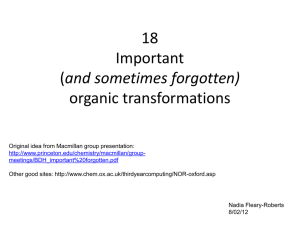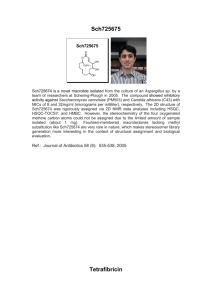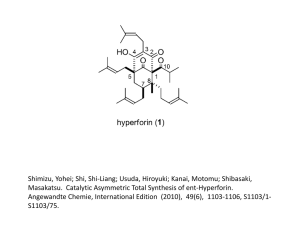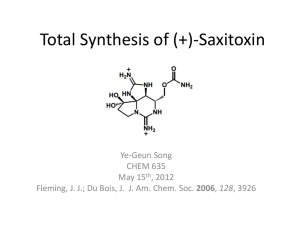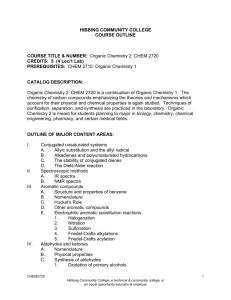named reactions
advertisement
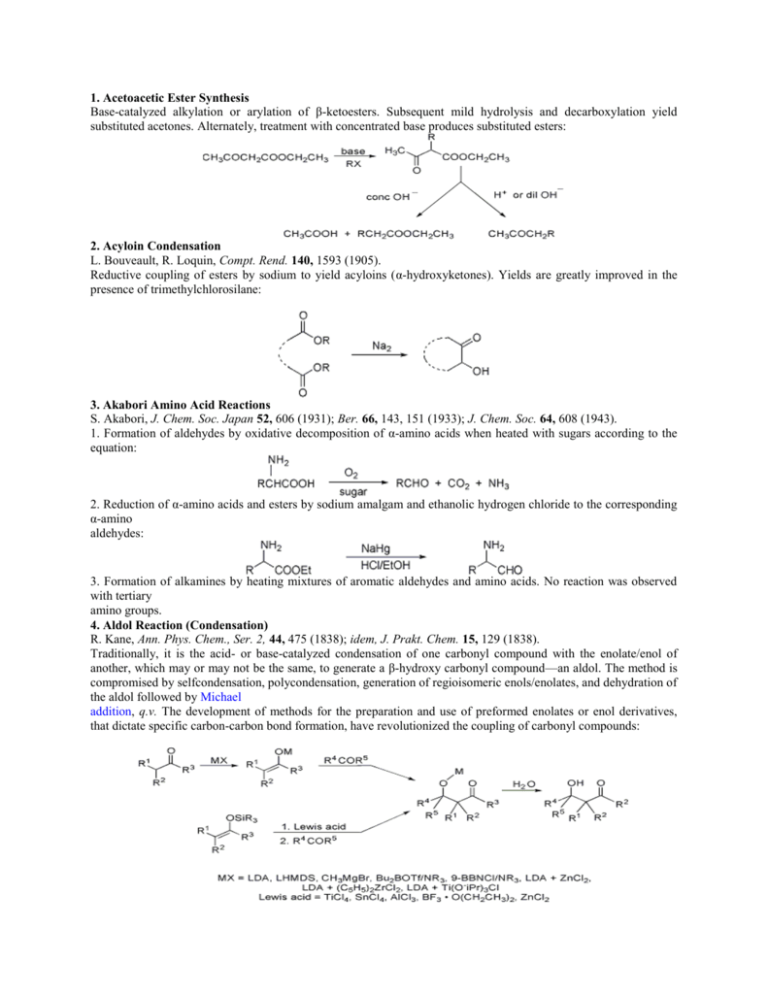
1. Acetoacetic Ester Synthesis Base-catalyzed alkylation or arylation of β-ketoesters. Subsequent mild hydrolysis and decarboxylation yield substituted acetones. Alternately, treatment with concentrated base produces substituted esters: 2. Acyloin Condensation L. Bouveault, R. Loquin, Compt. Rend. 140, 1593 (1905). Reductive coupling of esters by sodium to yield acyloins (α-hydroxyketones). Yields are greatly improved in the presence of trimethylchlorosilane: 3. Akabori Amino Acid Reactions S. Akabori, J. Chem. Soc. Japan 52, 606 (1931); Ber. 66, 143, 151 (1933); J. Chem. Soc. 64, 608 (1943). 1. Formation of aldehydes by oxidative decomposition of α-amino acids when heated with sugars according to the equation: 2. Reduction of α-amino acids and esters by sodium amalgam and ethanolic hydrogen chloride to the corresponding α-amino aldehydes: 3. Formation of alkamines by heating mixtures of aromatic aldehydes and amino acids. No reaction was observed with tertiary amino groups. 4. Aldol Reaction (Condensation) R. Kane, Ann. Phys. Chem., Ser. 2, 44, 475 (1838); idem, J. Prakt. Chem. 15, 129 (1838). Traditionally, it is the acid- or base-catalyzed condensation of one carbonyl compound with the enolate/enol of another, which may or may not be the same, to generate a β-hydroxy carbonyl compound—an aldol. The method is compromised by selfcondensation, polycondensation, generation of regioisomeric enols/enolates, and dehydration of the aldol followed by Michael addition, q.v. The development of methods for the preparation and use of preformed enolates or enol derivatives, that dictate specific carbon-carbon bond formation, have revolutionized the coupling of carbonyl compounds: 5. Algar-Flynn-Oyamada Reaction J. Algar, J. P. Flynn, Proc. Roy. Irish Acad. 42B, 1 (1934); B. Oyamada, J. Chem. Soc. Japan 55, 1256 (1934). Alkaline hydrogen peroxide oxidation of o-hydroxyphenyl styryl ketones (chalcones) to flavonols via the intermediate dihydroflavonols: 6. Allan-Robinson Reaction J. Allan, R. Robinson, J. Chem. Soc. 125, 2192 (1924). Preparation of flavones or isoflavones by condensing o-hydroxyaryl ketones with anhydrides of aromatic acids and their sodium salts: 7. Allylic Rearrangements L. Claisen, Ber. 45, 3157 (1912). Migration of a carbon-carbon double bond in a three carbon (allylic) system on treatment with nucleophiles under SN1 conditions (or under SN2 conditions when the nucleophilic attack takes place at the γ-carbon): 8. Amadori Rearrangement M. Amadori, Atti Accad. Nazl. Lincei 2(6), 337 (1925), C.A. 20, 902 (1926); ibid. 9(6), 68, 226 (1929), C.A. 23, 3211, 3443 (1929). Conversion of N-glycosides of aldoses to N-glycosides of the corresponding ketoses by acid or base catalysis: 9. Arens-van Dorp Synthesis; Isler Modification D. A. van Dorp, J. F. Arens, Nature 160, 189 (1947); J. F. Arens et al., Rec. Trav. Chim. 68, 604, 609 (1949); O. Isler et al., Helv. Chim. Acta 39, 259 (1956). The preparation of alkoxyethynyl alcohols from ketones and ethoxyacetylene. In the Isler modification the tedious preparation of ethoxyacetylene is obviated by treating β-chlorovinyl ether with lithium amide to yield lithium ethoxyacetylene, which is then condensed with the ketone: 10. Arndt-Eistert Synthesis F. Arndt, B. Eistert, Ber. 68, 200 (1935). Homologation of carboxylic acids: 11. Auwers Synthesis K. v. Auwers et al., Ber. 41, 4233 (1908); 48, 85 (1915); 49, 809 (1916); K. v. Auwers, P. Pohl, Ann. 405, 243 (1914). Expansion of coumarones to flavonols by treatment of 2-bromo-2-(α-bromobenzyl)coumarones with alcoholic alkali: 12. Baeyer-Drewson Indigo Synthesis A. Baeyer, V. Drewson, Ber. 15, 2856 (1882). Formation of indigos by an aldol reaction, q.v., of o-nitrobenzaldehydes to acetone, pyruvic acid or acetaldehyde; of interest mainly as a method of protecting o-nitrobenzaldehydes: 13. Baeyer-Villiger Reaction A. Baeyer, V. Villiger, Ber. 32, 3625 (1899); 33, 858 (1900). The oxidation of ketones to esters or lactones by peracids: 14. Baker-Venkataraman Rearrangement W. Baker, J. Chem. Soc. 1933, 1381; H. S. Mahal, K. Venkataraman, ibid. 1934, 1767. Base-catalyzed rearrangement of o-acyloxyketones to β-diketones, important intermediates in the synthesis of chromones and flavones: 15. Bamberger Rearrangement E. Bamberger, Ber. 27, 1347, 1548 (1894). Intermolecular rearrangement of N-phenylhydroxylamines in aqueous acid to give the corresponding 4 aminophenols: 16. Bamford-Stevens Reaction; Shapiro Reaction W. R. Bamford, T. S. Stevens, J. Chem. Soc. 1952, 4735. Formation of olefins by base-promoted decomposition of p-toluenesulfonylhydrazones of aldehydes and ketones: 17. Barbier(-type) Reaction P. Barbier, C. R. Acad. Sci. 128, 110 (1899). One-step procedure for the preparation of alcohols from organic halides and aldehydes or ketones 18. Barbier-Wieland Degradation H. Wieland, Ber. 45, 484 (1912); P. Barbier, R. Locquin, Compt. Rend. 156, 1443 (1913). Stepwise carboxylic acid degradation of aliphatic acids (particularly in sterol side chains) to the next lower homolog. The ester is converted to a tertiary alcohol that is dehydrated with acetic anhydride, and the olefin oxidized with chromic acid to a lower homologous carboxylic acid: 19. Bart Reaction; Scheller Modification H. Bart, DE 250264 (1910); DE 254092 (1910); DE 264924 (1910); DE 268172 (1912); Ann. 429, 55 (1922); E. Scheller, GB 261026; A. W. Ruddy et al., J. Am. Chem. Soc. 64, 828 (1942). Formation of aromatic arsonic acids by treating aromatic diazonium compounds with alkali arsenites in the presence of cupric salts or powdered silver or copper; in the Scheller modification primary aromatic amines are diazotized in the presence of arsenious chloride and a trace of cuprous chloride: The modified Bart reaction can be applied to the formation of arylstibonic acids: 20. Barton Decarboxylation D. H. R. Barton et al., Chem. Commun. 1983, 939; eidem, Tetrahedron 41, 3901 (1985). Radical decarboxylation of organic acids to the corresponding noralkane with tri-n-butyltin hydride or tbutylmercaptan: 21. Barton Deoxygenation (Barton-McCombie Reaction) D. H. R. Barton, S. W. McCombie, Perkin Trans. I 1975, 1574. Deoxygenation of alcohols via their thiocarbonyl derivatives which undergo free radical scission upon treatment with tri-nbutyltin hydride: 22. Barton Olefin Synthesis (Barton-Kellogg Reaction) D. H. R. Barton et al., Chem. Commun. 1970, 1226; R. M. Kellogg, S. Wassenaar, Tetrahedron Letters 1970, 1987; R. M. Kellogg et al., ibid. 4689. Olefin synthesis by two-fold extrusion of nitrogen and sulfur from a Δ3-1,3,4-thiadiazoline intermediate. Particularly applicable to the synthesis of moderately hindered tetra-substituted ethylenes: 23. Barton Reaction D. H. R. Barton et al., J. Am. Chem. Soc. 82, 2640 (1960); 83, 4076 (1961). Conversion of a nitrite ester to a γ-oximino alcohol by photolysis involving the homolytic cleavage of a nitrogenoxygen bond followed by hydrogen abstraction: 24. Barton-Zard Reaction D. H. R. Barton et al., Tetrahedron 46, 7587 (1990). Formation of a pyrrole by condensation of a substituted nitroso-alkene with an isocyanoester: 25. Baudisch Reaction O. Baudisch et al., Naturwiss. 27, 768, 769 (1939); Science 92, 336 (1940); J. Am. Chem. Soc. 63, 622 (1941). Synthesis of o-nitrosophenols from benzene or substituted benzenes, hydroxylamine and hydrogen peroxide in the presence of copper salts: 26. Baylis-Hillman Reaction A. B. Baylis, M. E. D. Hillman, DE 2155113; eidem, US 3743669 (1972, 1973 both to Celanese). Coupling of activated vinyl systems with aldehydes, catalyzed by 1,4-diazabicyclo[2.2.2]octane (DABCO), to yield α-hydroxyalkylated or -arylated products: 27. Béchamp Reduction A. J. Béchamp, Ann. Chim. Phys. 42(3), 186, (1854). Reduction of aromatic nitro compounds to the corresponding amines by iron, ferrous salts or iron catalysts in aqueous acid: 28. Beckmann Rearrangement; Beckmann Fragmentation E. Beckmann, Ber. 19, 988 (1886). Acid-mediated isomerization of oximes to amides. Oximes of cyclic ketones give ring enlargements: Certain oximes, particularly those having a quarternary carbon anti to the hydroxyl, are likely to undergo the Beckmann fragmentation to form nitriles instead of amides: 29. Bénary Reaction E. Bénary, Ber. 63, 1573 (1930); 64, 2543 (1931). Action of Grignard reagents on enamino ketones or aldehydes yields β-substituted α,β unsaturated ketones or aldehydes: 30. Benkeser Reduction R. A. Benkeser et al., J. Am. Chem. Soc. 74, 5699 (1952); 77, 3230 (1955). Reduction of aromatic and olefinic compounds with lithium or calcium and low molecular weight amines to monounsaturated olefins, as well as the fully reduced products. The extent of reduction and selectivity can be controlled by varying the reaction conditions: 31. Benzidine Rearrangement; Semidine Rearrangement A. W. Hofmann, Proc. Roy. Soc. London 12, 576 (1863); P. Jacobson et al., Ber. 26, 688 (1893). Acid-catalyzed rearrangement of hydrazobenzenes to 4,4′-diaminobiphenyls. If the hydrazobenzene contains a para substituent, then the favored product is p-aminodiphenylamine (Semidine rearrangement): 32. Benzilic Acid Rearrangement (Benzil-Benzilic Acid Rearrangement) J. Liebig, Ann. 25, 27 (1838); N. Zinin, ibid. 31, 329 (1939). Base-induced rearrangement of benzil to benzylic acid via phenyl group migration. More commonly perceived to include the migrations of other groups in α-dicarbonyl compounds: 33. Benzoin Condensation A. J. Lapworth, J. Chem. Soc. 83, 995 (1903); 85, 1206 (1904). Cyanide-catalyzed condensation of aromatic aldehydes to give benzoins (acyloins): 34. Bergius Process F. Bergius, Gas World 58, 490 (1913); GB 18232 (1914). Formation of petroleum-like hydrocarbons by hydrogenation of coal at high temperatures and pressures (e.g., 450°C and 300 atm) with or without catalysts; production of toluene by subjecting aromatic naphthas to cracking temperatures at 100 atm with a low partial pressure of hydrogen in the presence of a catalyst. 35. Bergman Reaction R. R. Jones, R. G. Bergman, J. Am. Chem. Soc. 94, 660 (1972); R. G. Bergman, Accts. Chem. Res. 6, 25 (1973). The cyclization of enediynes to generate 1,4-benzenoid diradicals: 36. Bergmann Azlactone Peptide Synthesis M. Bergmann et al., Ann. 449, 277 (1926). Conversion of an acetylated amino acid and an aldehyde into an azlactone with an alkylene side chain, reaction with a second amino acid with ring opening and formation of an acylated unsaturated dipeptide, followed by catalytic hydrogenation and hydrolysis to the dipeptide: 37. Bergmann Degradation M. Bergmann, Science 79, 439 (1934). Stepwise degradation of polypeptides involving benzoylation, conversion to azides and treatment of the azides with benzyl alcohol; this treatment yields, via rearrangement to isocyanates, carbobenzoxy compounds which undergo catalytic hydrogenation and hydrolysis to the amide of the degraded peptide:
